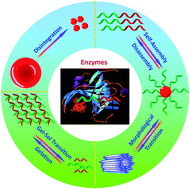Enzyme-responsive polymeric assemblies, nanoparticles and hydrogels†
Abstract
Being responsive and adaptive to external stimuli is an intrinsic feature characteristic of all living organisms and soft matter. Specifically, responsive polymers can exhibit reversible or irreversible changes in chemical structures and/or physical properties in response to a specific signal input such as pH, temperature, ionic strength, light irradiation, mechanical force, electric and magnetic fields, and analyte of interest (e.g., ions, bioactive molecules, etc.) or an integration of them. The past decade has evidenced tremendous growth in the fundamental research of responsive polymers, and accordingly, diverse applications in fields ranging from drug or gene nanocarriers, imaging, diagnostics, smart actuators, adaptive coatings, to self-healing materials have been explored and suggested. Among a variety of external stimuli that have been utilized for the design of novel responsive polymers, enzymes have recently emerged to be a promising triggering motif. Enzyme-catalyzed reactions are highly selective and efficient toward specific substrates under mild conditions. They are involved in all biological and metabolic processes, serving as the prime protagonists in the chemistry of living organisms at a molecular level. The integration of enzyme-catalyzed reactions with responsive polymers can further broaden the design flexibility and scope of applications by endowing the latter with enhanced triggering specificity and selectivity. In this tutorial review, we describe recent developments concerning enzyme-responsive polymeric assemblies, nanoparticles, and hydrogels by highlighting this research area with selected literature reports. Three different types of systems, namely, enzyme-triggered self-assembly and aggregation of synthetic polymers, enzyme-driven disintegration and structural reorganization of polymeric assemblies and nanoparticles, and enzyme-triggered sol-to-gel and gel-to-sol transitions, are described. Their promising applications in drug controlled release, biocatalysis, imaging, sensing, and diagnostics are also discussed.

- This article is part of the themed collection: Supramolecular polymers

 Please wait while we load your content...
Please wait while we load your content...